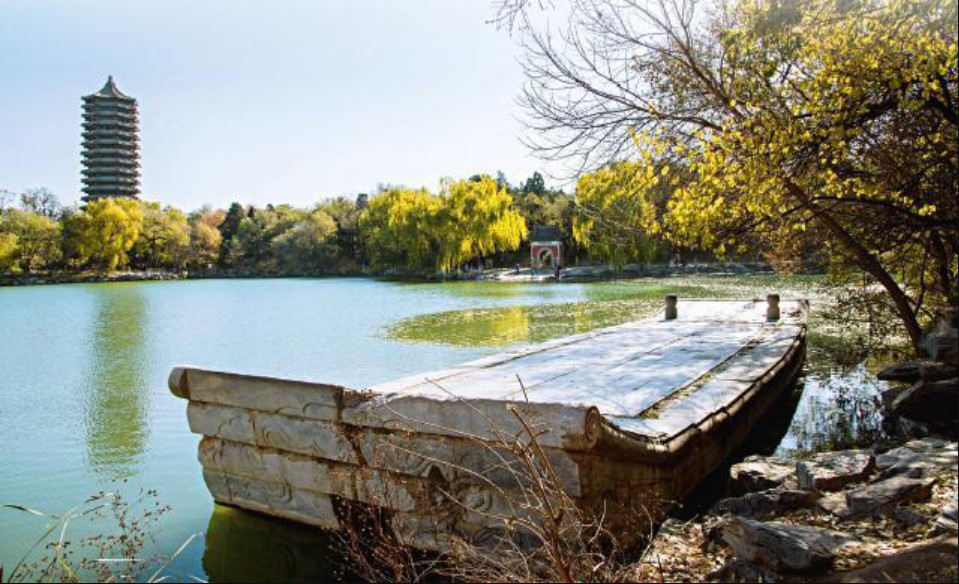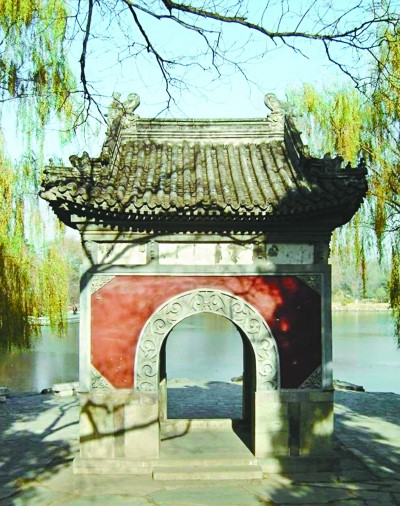[Peking University Landmark] Shuchun Garden
May 12, 2020
Peking University, May 12, 2020: The Shuchun Garden lays the foundation of the core campus of the former Yenching University and today’s Peking University. “Shu” refers to the quality of kindness and good-heartedness while “Chun” means spring. The Shuchun Garden ranges from the West Gate to the Weiming Lake, including some of the most representative sites and cultural relics of Peking University such as the Boya Pagoda and the Marble Boat Base. The Garden, along with other architectures centering on the Weiming Lake of the PKU campus, also known as Yan Garden, was listed as a key cultural relic site under state protection in 2001.
The Boya Pagoda and the Marble Boat Base. The Marble Boat’s upper wooden structure was burned down by foreign predators; the base silently lies in the middle of the Weiming Lake
The Shuchun Garden has weathered through ups and downs in history. The Shuchun Garden was built no later than the twenty-eighth year of the Qianlong Emperor’s Reign (1763), but the landscape was not impressive until it became the private garden of Heshen, one of Qianlong’s most powerful officials. Before Qianlong bestowed it to Heshen, the landscape was a vast undeveloped wasteland. After the bestowal, Heshen renamed the Shuchun Garden as the Shihu Garden. Heshen clearly did not like the wilderness and sought to alter it. A big-scale construction was underway - paddy fields were changed into pavilions, terraces and multi-storied buildings, and the landscape became attention-grabbing due to its grandeur. According to the report to Qianlong by Yongxi (Prince Su, Qianlong’s Third Cousin) and the others who were ordered to confiscate Heshen’s property, there were 1003 rooms altogether and 357 porches, chambers and pavilions. Naturally, it is the Shuchun Garden that became the thirteenth charge against Heshen among the twenty-one: “The decorations in his garden are very much the same as the Immortal Abode on Penglai Island (Pengdao Yaotai) in the Yuanming Yuan (The Old Summer Place). What does he mean by that?”
After Heshen’s death in the fourth year of the Jiaqing Emperor’s reign (1799), the Shuchun Garden was divided into two parts: the bigger eastern part was given to Yongxing, Qianlong’s eleventh son, while Fengshen Yinde (Heshen’s elder son) and his wife, the Tenth Princess (also Qianlong’s youngest child), resided in the western part. In 1823, after Yongxing and the Tenth Princess died successively, the Shuchun Garden was, by customary rule, confiscated by the Imperial Household Department. Later it was given to Prince Rui, Jiaqing’s fourth son, and renamed again as the Garden of Prince Rui. In the following years, the owners of the Shuchun Garden had changed several times and its extravagant construction had gone as well. The most severe destruction happened in 1860 when the Anglo-French Allied Forces invaded Beijing and set the Yuanming Yuan on fire. By 1881 or so, the Shuchun Garden was reduced to one large structure, the Linfeng Daiyue Building (“Linfeng” means standing against the breeze while “Daiyue” means waiting for the moon). The Garden’s situation worsened when it was burnt again by the forces of the Eight-Nation Alliance later in 1900. After the two fires, the Shuchun Garden was almost in ruins: the original Linfeng Daiyue Building was gone, and only a few remnants such as the Marble Boat Base and the Ciji Temple Gate remained.
Ciji Temple Gate was destroyed by foreign predators, only with the gate mourning the past glamour by the Weiming Lake
The Shuchun Garden embraced its new life when it was selected by John Leighton Stuart as the new site of Yenching University in 1920. The Yenching University invited Henry Murphy, a famous American architect, to design the new campus. American architect as he was, Murphy’s design met the requisites of a modern university while maintaining a typical Chinese architectural style. After seven years of construction, by 1929, the new campus of Yenching University was formally put into use and was known as the Yan Garden ever since. In the days to come, the Yan Garden, which centered on the Shuchun Garden in 1920, gradually expanded from the original 40-acre core area. In 1952, it was taken over by Peking University.
Today, the Shuchun Garden is the most attractive part of Peking University, enjoyed by both tourists and PKUers. Besides, it is the very place where one can actually touch and feel the history of China and Peking University.
References:
郝平主编:《燕园文物》,外语教学与研究出版社2018年版。
侯仁之:《北京城的生命印记》,生活·读书·新知三联书店,2009年3月版。
肖东发:《风物:燕园景观及人文底蕴》,北京图书馆出版社2003年版。
https://www.dpm.org.cn/court/talk/206986.html
https://news.pku.edu.cn/wyyd/wytd/ce34a8d5dc7b4bfd89bde77e961f76c7.htm
http://newsen.pku.edu.cn/news_events/news/campus/8442.htm
Written by: Ye Yimeng
Edited by: Zhang Jiang, Yan Shengnan, NG Joong Hwee
Photo credit to: Lv Chen



